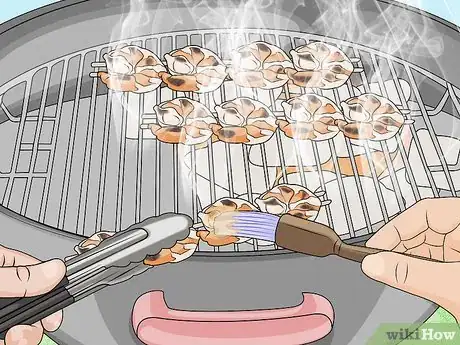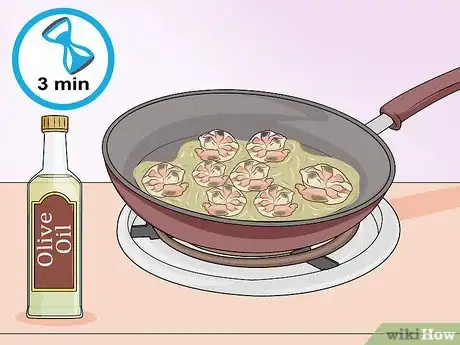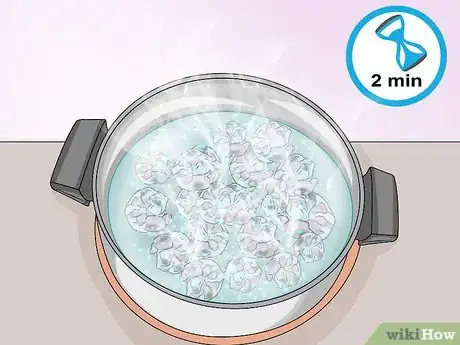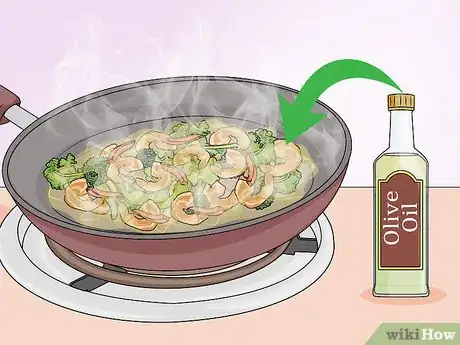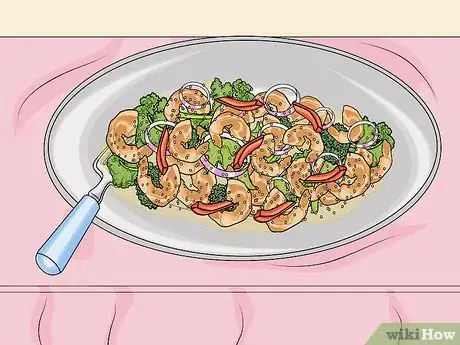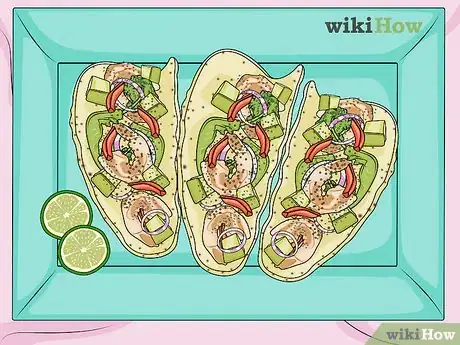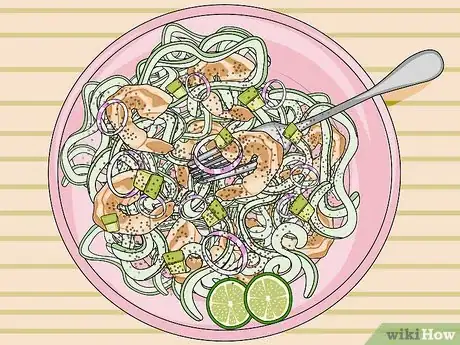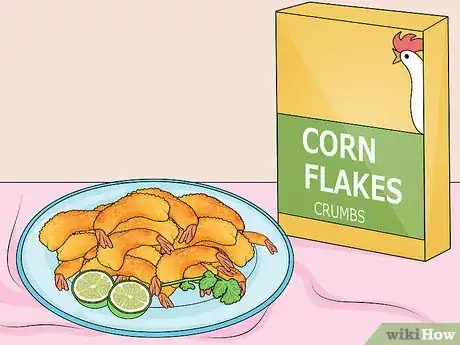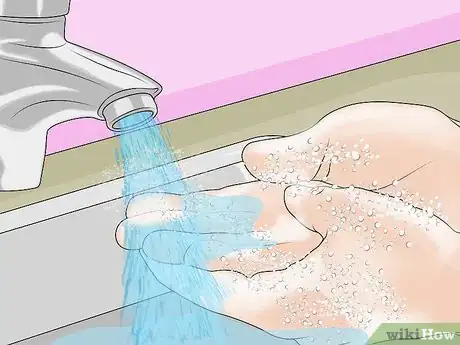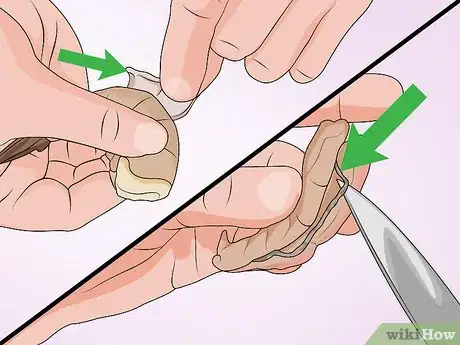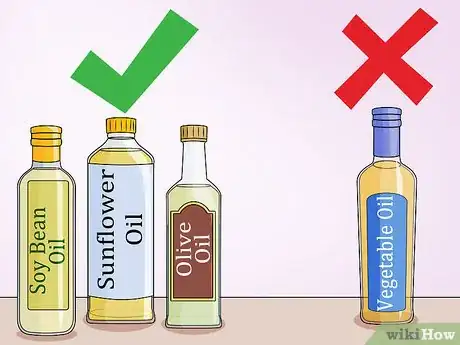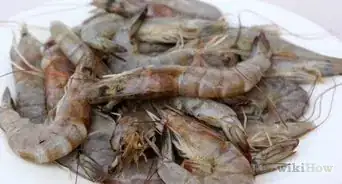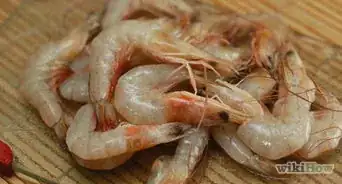This article was co-authored by Jennifer Lease, RD, CDN. Jennifer Lease is a Registered Dietitian and Trained Chef based in Denver, Colorado. With six years of experience in the food and nutrition fields, she specializes in a plant-forward approach to applying nutrition information to cooking. Jennifer holds a BS in Dietetics and a Dietetic Internship Certificate from The University of Delaware. She also received her professional chef training from The Natural Gourmet Institute for Health and Culinary Arts.
There are 9 references cited in this article, which can be found at the bottom of the page.
This article has been viewed 23,296 times.
Shrimp is a healthy, low calorie source of protein. If served correctly, it can be a healthy addition to any diet. To prepare healthy shrimp, cook your shrimp using methods like steaming and grilling. Serve your shrimp with healthy foods like salads and low-calorie pastas. Always wash your hands before handling shrimp to avoid food poisoning.
Steps
Cooking Shrimp in a Healthy Way
-
1Steam your shrimp. Steaming your shrimp does not add any extra calories and fat through cooking oils.[1] To steam your shrimp, place your shrimp in a covered basket with small holes. Place this basket above a pot of boiling water. The heat from the steam will cook the shrimp.[2]
- Steaming takes about five to six minutes.[3] Shrimp will turn a pinkish color when they're done.
- Any prep work, such as shelling or seasoning the shrimp, should be done prior to steaming them.
-
2Grill your shrimp. Grilling shrimp also limits additives.[4] First, brush the shrimp with oil or a non-stick spray. Place your shrimp near the edge of the grill. After a few minutes, your shrimp will start to release some moisture. At this point, flip your shrimp and allow them to cook for a few minutes on the other side.[5]
- You can use grilling skewers or a grill basket to prevent your shrimp from falling through the grill grates.
Advertisement -
3Saute your shrimp. While sauteeing shrimp calls for the use of oil, heart healthy oils like olive oil will keep your dish healthy.[6] Olive oil can also add some flavor. Heat up your oil in a pan over medium heat and then add the shrimp. Cook the shrimp for two to three minutes on each side. When done, the shrimp should be a bright, pink shade.[7]
- While olive oil is healthy, it is high in calories. Make sure to only use a small amount of oil while cooking your shrimp. The precise amount depends on how many shrimp you're grilling, as more shrimp need more oil, but try to stick to only one to two tablespoons.
-
4Boil your shrimp. Boiling your shrimp only requires water and a bit of salt, so it does not add calories to the shrimp. Add your water and shrimp to a pot. Bring it to a boil. Allow it to boil for only two minutes before removing the pot from the heat. Cover the pot and let it sit for five to ten minutes before serving your shrimp.[8]
- Smaller shrimp only need about five minutes to cook, while larger ones should cook for closer to ten minutes.
Serving Shrimp in Healthy Recipes
-
1Add shrimp to a veggie stir fry. Vegetables cooked with a little olive oil and flavoring over the stove is a great, nutritious dish for dinner or lunch. Toss in a few shrimp and cook them with your stir fry. This will add some protein and result in a healthy meal that includes shrimp.[9]
- Remember to limit your use of oil, as it's high calorie.
- You can add any flavor profile you want to a stir fry, so experiment with different spices.
-
2Eat shrimp with salads. A salad is a healthy choice for a lunch. Adding shrimp to a salad can give it a protein boost, resulting in a meal that will keep you full longer. This cuts down on snacking throughout the day. [10]
- Do not overdo it with salad dressing. Stick to things like vinaigrettes over creamy, high calorie dressings.
-
3Have shrimp tacos. If you serve tacos with whole wheat, low calorie tortillas, shrimp tacos can be a healthy choice for any meal. Add healthy foods to the tacos, such as peppers, avocados, and lettuce. If you add things like cheese and salsa, keep it minimal to avoid extra fat, salt, and calories.[11]
-
4Eat shrimp with cucumber noodles. Shrimp can make an excellent addition to a noodle bowl. However, avoid starchy noodles that are high in calories. Instead, opt for noodles made out of thin strands of sliced cucumber. These will give your noodle dish an extra crunch and added nutrition. Flavor your noodle bowl with toppings like soy or peanut sauce.[12]
- Add vegetables to your noodle bowl to make it extra healthy.
-
5Find healthier ways to bread shrimp. Many people prefer to bread shrimp. Breading shrimp can add unnecessary carbs, starch, and calories. Instead of using conventional breadcrumbs, try using healthier options like cornflakes, coconut crumbs, oats, rosemary, or dried herbs. These will add flavor and crunch but provide more nutrients than simple breadcrumbs.[13]
- You can also try whole wheat breadcrumbs.
Avoiding Unhealthy Practices
-
1Wash your hands before and after handling your shrimp. When handling raw meat, wash your hands under running water first. This will keep you from adding bacteria to the shrimp. You should also wash your hands thoroughly after handling raw shrimp to prevent the spread of foodborne illnesses.[14]
-
2Peel and de-vein your shrimp. If your shrimp is not already peeled and de-veined when you purchase it, do this at home prior to cooking. Peel a shrimp by hand by removing its legs and then peeling off the shell. You should be able to see the thin blue vein running through the shrimp. Make a shallow cut near the top of the shrimp, grab onto the vein, and gently pull it out.[15]
- Eating the vein is not harmful, and you can skip de-veining in a rush. However, many people dislike the taste and texture of the vein.
-
3Pick out the right shrimp. When choosing shrimp at the supermarket, make sure you choose the best shrimp. Fresher shrimp will taste better and be healthier overall.[16]
- Avoid shrimp that gives off a fishy odor or an ammonia-like smell.
- Fresh shrimp should be translucent and shiny.
- Avoid mushy, slimy shrimp.
-
4Opt for healthy cooking oils. When cooking with oils, make sure to opt for healthy oils. Oils high in fat and calories can make a shrimp dish less healthy. Avoid vegetable oil when cooking. Instead, go for olive, soy bean, sunflower, peanut, corn, or canola oil.[17]
References
- ↑ Jennifer Lease, RD, CDN. Registered Dietitian & Trained Chef. Expert Interview. 15 September 2021.
- ↑ http://www.shape.com/healthy-eating/cooking-ideas/5-healthiest-ways-cook
- ↑ https://www.macheesmo.com/how-to-steam-shrimp/
- ↑ Jennifer Lease, RD, CDN. Registered Dietitian & Trained Chef. Expert Interview. 15 September 2021.
- ↑ http://dish.allrecipes.com/5-healthy-ways-to-cook-fish/
- ↑ Jennifer Lease, RD, CDN. Registered Dietitian & Trained Chef. Expert Interview. 15 September 2021.
- ↑ https://thrivemarket.com/blog/healthy-ways-to-cook-raw-shrimp
- ↑ https://thrivemarket.com/blog/healthy-ways-to-cook-raw-shrimp
- ↑ http://www.shape.com/healthy-eating/cooking-ideas/5-healthiest-ways-cook
- ↑ http://www.mensfitness.com/nutrition/what-to-eat/protein-power-shrimp
- ↑ https://thrivemarket.com/blog/healthy-ways-to-cook-raw-shrimp
- ↑ https://thrivemarket.com/blog/healthy-ways-to-cook-raw-shrimp
- ↑ http://www.cookingforbusymums.com/10-alternatives-to-bread-crumbs/
- ↑ https://thrivemarket.com/blog/healthy-ways-to-cook-raw-shrimp
- ↑ http://www.thekitchn.com/how-to-peel-amp-devein-shrimp-cooking-lessons-from-the-kitchn-217120
- ↑ https://thrivemarket.com/blog/healthy-ways-to-cook-raw-shrimp
- ↑ http://www.heart.org/HEARTORG/HealthyLiving/HealthyEating/SimpleCookingandRecipes/Healthy-Cooking-Oils_UCM_445179_Article.jsp


